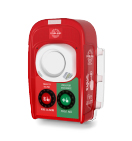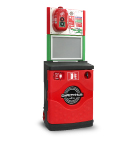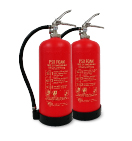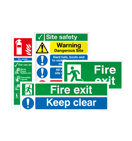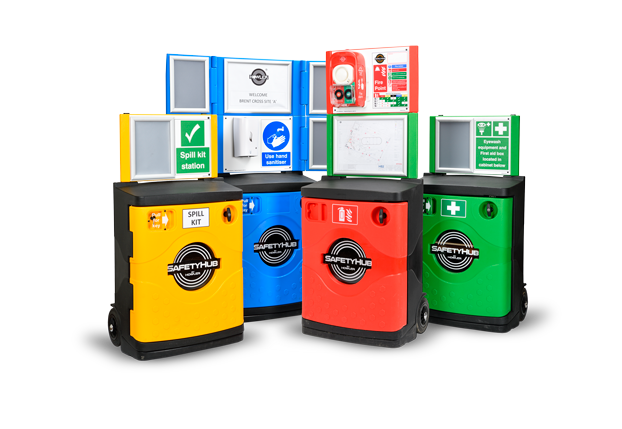Avoiding potential ignition sources is crucial. According to the Health and Safety Executive (HSE), there is, on average, a fire every hour on construction sites in the UK.
These incidents encompass a spectrum of scenarios, from minor outbursts to colossal fires demanding the coordinated efforts of multiple firefighting teams.
The JCoP and HSE’s Fire Safety in Construction resources aim to prevent construction site fires. They do this by reducing the potential ignition source and fuel risks.
For your convenience, we offer free downloadable resources that include this important information.
Read on for a concise overview of key considerations to effectively minimise the likelihood of fire outbreaks on your construction site…
| Reducing the Sources of Ignition & Fuel on Site
|
| Fire Risk Assessment: Reduce Sources of Ignition & Fuel |
- Your FRA will help you to identify what hazards you have on-site and therefore what precautions and rules you need to make
|
| Smoking |
- Current UK legislation requires a ‘No Smoking’ policy on construction sites
- Designated open-air smoking areas should be of low fire risk design
- On very high-risk sites, increased policing and controls will be needed to reflect the increase in the potential for a fire to start
- All workers and visitors should have the smoking rules brought to their attention
|
| Plant & Equipment |
- Equipment should be appropriate for the task and it’s working location (consider ventilation/fumes/obstruction of escape routes)
- Storage and maintenance of equipment is important, to prevent overheating etc
- Consider where equipment is operated and refuelled, for example only refuel in well-ventilated or open-air locations, never on escape routes or scaffold
- Bulk flammable fuel should be stored in bunded tanks
- Operation of petrol/diesel equipment in confined areas can lead to carbon monoxide build-up, so consider electric alternatives
|
| Electrical Equipment |
- Maintenance of temporary lighting is important as they can become an ignition source if damaged
- Never cover electrical equipment
- Ensure equipment is cleared of dust (especially vents) before use
- Recharging of electrical equipment should take place away from ignition sources
- In areas with a potentially flammable atmosphere (eg fuel storage or when floor laying or paint spraying) ensure electrical equipment is of correct standard (use ATEX 94/9/EC or equivalent explosion protection standard)
|
| Electrical Installations |
- Should be suited to task, and designed, installed, inspected and maintained by competent personnel
- Should meet BS 7671:2008
- Risks to consider include: using twin and earth cable instead of flex for extension leads; overriding safety devices such as fuses; overloading sockets
|
| Flammable Liquids/Gases |
- Areas with an explosive atmosphere (spray painting/flammable liquid storage etc) have to be classified into hazardous ‘zones’ and the correct category of explosion-protected equipment used
- Find more information on Zoning in HSG140 notes (The Safe Use & Handling of Flammable Liquids)
|
| Oxy-Fuel Equipment |
- This should only be used by competent workers
- HSG139 provides detailed guidance
- Ensure you use the correct colour-coded hoses, non-return valves etc
|
| Hot Work: Permit-to-Work (PTW) Systems |
- The level of system required is dependent on the risks involved
- A PTW is a formal system to prevent fire risks and should only be issued by those with assigned authority
- Points laid out must be complied with before the permit is issued
- A PTW is specific to task location and period of time: it is not a blanket permit for Hot Work anywhere on site
|
| Bonfires |
- These should be avoided unless absolutely necessary (eg on major road construction clearing)
- Approval must be given by clients and any relevant authorities
- If permitted, a FRA be in place and also a permit system
- Fire size must be limited, eg in a properly designed incinerator
- Fires must never be left unattended
- Bonfires must be located away from any areas at risk of catching alight
- Contents of the fire must be checked before lighting
|
| Arson & Site Security |
- Arson can be a substantial problem on construction sites
- Trespassers should be prevented from gaining access
- Flammable liquids and combustible material should be securely stored when the site is closed
- Consideration should be give to the site location and any history of arson in the vicinity
- Consider using patrols, security lighting, CCTV and liason with the police
- Skips are often targetted
- Procedures should be in place for when a fire is detected
- Site employees can be responsible, so be aware
|
| Dangerous Substances & Explosive Atmospheres Regulations 2002 (DSEAR) |
- DSEAR put duties on the employers and the self-employed to protect people from fires, explosions and similar events in the workplace. This includes members for the public who may be endangered by work activity
- Action Points:
- Find out what dangerous substances are in the workplace and what the fire and explosion risks are
- Put control measures in place to remove or reduce these risks and put controls in place to reduce the effects of any incidents
- Draw up procedures to deal with incidents involving dangerous substances – ensure employees are properly trained to control or deal with the risks from any dangerous substances on site
- Identify and classify areas of the workplace where explosive atmospheres may occur and avoid ignition sources in those areas (eg from unprotected equipment)
|
| Combustible Materials – Handling & Storage |
- Be aware that nominally flame-retardant materials can become flammable when in dust or fine material form
- Store flammable materials (eg LPG) outdoors in a secure compound (see HSG168 for detailed guidance)
- If an internal store is necessary, they should be constructed with 30 minutes fire resistance
- Ensure paint or flammable liquid stores are not on emergency routes or near fire exits
- Store access should be controlled to prevent materials getting spread around the site
|
| Acetylene |
- Avoid using acetylene if possible, due to its high flammability
- Strict storage, usage and transportation regulations apply – see HSG168 for guidance
- Acetylene must only be used by competent workers
|
| Protective Coatings & Scaffold Nets |
- Protective coverings over finished surfaces should be flame retardant material
- All scaffold wrapping and netting should be flame retardant
|
| Rubbish Disposal |
- The Environment Agency enforce the rules for Site Waste Management Plans Regulations
- The fire risk of all waste produced should be considered when writing the plans
- Rules must be set and adhered to for the location and disposal of rubbish and skips
|
Please remember that our above information on Ignition Sources and fuel risks provides a (comparatively!) brief interpretation of the JCoP. Please refer to the complete documents using the links below for comprehensive information:
JCoP 9th Edition: Fire Prevention on Construction Sites
HSG168: Fire Safety in Construction
HSG139: The Safe Use of Compressed Gases in Welding, Flame Cutting and Allied Processes
HSG140: Safe Use and Handling of Flammable Liquids
Dangerous Substances and Explosive Atmospheres Regulations 2002 (DSEAR)
